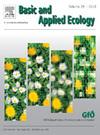城市环境中的保护性迁移:知识现状与未来方向
IF 3.5
2区 环境科学与生态学
Q2 ECOLOGY
引用次数: 0
摘要
城市对生物多样性保护非常重要,也是联合国生态系统恢复十年的核心重点。物种再引入和种群强化(即保护性迁移)是保护工作的重要组成部分,但在城市环境中却很少见,这可能是因为在高度变化和复杂的社会-生态城市系统中存在可感知的风险。在此,我们回顾了有关城市保护性迁移的文献,为其有效实施提供指导。我们发现,进行城市迁移的目的多种多样,包括保护重点物种、在恢复项目的后期阶段改善生态系统功能(如在重新植被的地点播撒种子)、进行场地修复(如清除有机污染)以及加强人与自然的联系。在一系列城市栖息地类型中发现了保护性迁移,包括正规和非正规绿地、灰色空间、溪流、池塘和海洋环境,范围从接近历史条件(如残留/修复场地)到高度改造的新型/设计系统。陆生和水生放归地的障碍和有利因素各不相同,陆生放归地的天敌、栖息地适宜性和离开放归地更为重要,而水生放归地的干扰(洪水)机制和污染更为重要。已经采用了一系列技术来减少这些障碍。城市迁移的成功率很高(90%),可与一般的保护性迁移相媲美,这表明迁移可以帮助物种克服扩散障碍,占据原本合适的城市栖息地,从而为保护城市生物多样性做出贡献。然而,不同城市迁移研究的评估方法大相径庭。此外,还需要对迁移成功与否进行更长期的监测,并通过公民科学计划加强人与自然的联系。本文章由计算机程序翻译,如有差异,请以英文原文为准。
Conservation translocations in urban environments: State of the knowledge and future directions
Cities are important for biodiversity conservation and are a central focus in the United Nations Decade of Ecosystem Restoration. Species reintroductions and population reinforcements (i.e. conservation translocations) are an important component of conservation, yet are rare in urban environments, possibly because of perceived risks in highly modified and complex social-ecological urban systems. Here we review the literature describing urban conservation translocations to provide guidance for their effective implementation. We find that urban translocations have been performed for a variety of aims including focal species conservation, improvements in ecosystem functions in the later stages of restoration projects (e.g. seed dispersal in revegetated sites) and for site remediation (e.g. organic pollution removal), and enhancing human-nature connections. Conservation translocations were found in a range of urban habitat types including formal and informal greenspaces, grey spaces, streams, ponds, and marine environments, ranging from near-historic conditions (e.g. remnant/restored sites) to highly modified novel/designed systems. Barriers and enablers varied between terrestrial and aquatic release sites, with predators, habitat suitability, and leaving release sites being more important in terrestrial sites and disturbance (flooding) regime and pollution being more important in aquatic sites. A range of techniques have been applied to mitigate these barriers. Success rates in urban translocations are high (>90 %) and comparable to conservation translocations in general, suggesting they can contribute to urban biodiversity conservation by assisting species to overcome dispersal barriers and occupy otherwise suitable urban habitats. However, evaluation methods vary widely between urban translocation studies. There is also a need for longer-term monitoring of translocation success that might be achieved simultaneously while enhancing human-nature connections through citizen science programs.
求助全文
通过发布文献求助,成功后即可免费获取论文全文。
去求助
来源期刊

Basic and Applied Ecology
环境科学-生态学
CiteScore
6.90
自引率
5.30%
发文量
103
审稿时长
10.6 weeks
期刊介绍:
Basic and Applied Ecology provides a forum in which significant advances and ideas can be rapidly communicated to a wide audience. Basic and Applied Ecology publishes original contributions, perspectives and reviews from all areas of basic and applied ecology. Ecologists from all countries are invited to publish ecological research of international interest in its pages. There is no bias with regard to taxon or geographical area.
 求助内容:
求助内容: 应助结果提醒方式:
应助结果提醒方式:


